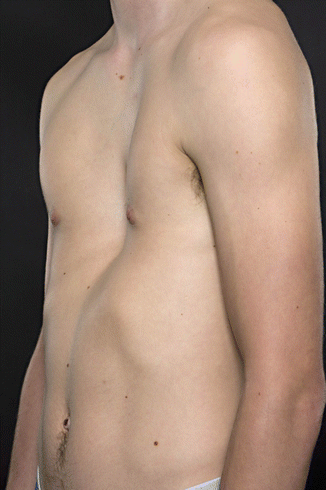Fig. 4.1
Right side view in a 16-year-old

Fig. 4.2
Left side view in a 16-year-old

Fig. 4.3
Front view in a 16-year-old
The incidence of PE has a ratio between 1 and 8 per 1000 children [10]. Interestingly, males are more often affected, with a gender distribution between 2:1 and 9:1 [11]. From the 19th century it has been recognised a genetic predisposition since a positive family history could be found in up to 43 % of PE cases [12, 13]. However, a specific genetic defect has not yet been found. Numerous syndromes are associated with PE and have been well described [14] where connective tissue disorder occurs in less than 1 % of all cases [15].
The majority of the patients with PE are tall, slim with associated scoliosis [14–16]. Severe depression of the sternum can cause displacement of the heart and reduction of lung volume [13, 17]. As a result of the anatomical changes, chest pain [12, 13, 15], fatigue [15], dyspnoea on exertion [12, 13, 15, 18], respiratory infections [13], asthma symptoms [13], palpitations [12] or heart murmurs could occur [13]. Several cases with mitral valve prolapse [13, 15, 19], mitral valve regurgitation and ventricle compression could be found [15, 17, 19]. For the latter, Coln [19] demonstrated that 95 % of 123 patients had cardiac compression. Even a single case report of syncopal symptoms has been reported. The pulmonary and cardiovascular functions of patients with PE deformities were analysed in many investigations and have revealed measurable deficiencies [12]. Fonkalsrud [13] reported that the symptoms of many untreated PE patients become progressively worse with age and he recommended an operational intervention for both young and adult patients.
In contrast to these descriptions of more or less severe clinical signs, symptoms affecting daily life activities are either rare [20]. Therefore, some authors described the indication for a PE correction to be primarily cosmetic.
Numerous clinical studies described an improvement of pulmonary and/or cardiovascular symptoms and improvement in the subjective well-being after surgical correction [9, 13, 16–18]. Malek [18, 21] concluded that an operative intervention improves cardiovascular but not pulmonary function. Guntheroth [22] and Spiers as well as Johnson [23] re-evaluated the source data of Malek’s meta-analyses and stated that due to relevant methodological deficits, these data failed to demonstrate any improvement of cardiac function. In this context, Aronson et al. [24] could not show an improvement in lung function parameters after Nuss procedure. Regardless the impact of the chest wall surgery to cardiopulmonary function the effect to psychological status of the patient is significant [15]. Numerous studies confirm that deformities cause relevant social discrimination, especially during adolescence, leading to the socio-psychologic problems [15]. A multicentre study demonstrated that the surgical repair of PE patients improves these socio-psychologic problems. [25–32]
References
1.
Bauhinus J. Johannes Observatorium medicarum, rararum, novarum, admirabilium, et montrosarum, liber secundus. In: Ioannis Schenckii a Grafenberg, editor. Observation. Frankfurt: De partibus vitalibus, thorace contentis; 1609. p. 322.
2.
Woillez. Sur un cas de deformitée thoracique considérable avec deplacement inoffensif de plusieur organes et signes sthetoscopiaques particulières. Paris: Rap Soc Med d’Hop; 1860. p. 3.
3.
von Luschka H. Die Anatomie der Brust des Menschen. Die Anatomie des Menschen in Rücksicht auf die Bedürfnisse der praktischen Heilkunde. Tübingen: Laupp; 1863. p. 23
5.
Williams CT. Congenital malformation of the thorax great depression of the sternum. Trans Path Soc. 1872;24:50.
6.
Flesch M. Über eine seltene Missbildung des Thorax. Virchows Arch Path Anat. 1873;75:289.CrossRef
7.
Hagmann. Selten vorkommende Abnormität des Brustkastens. Jb Kinderheilkunde. 1888;15:455.



